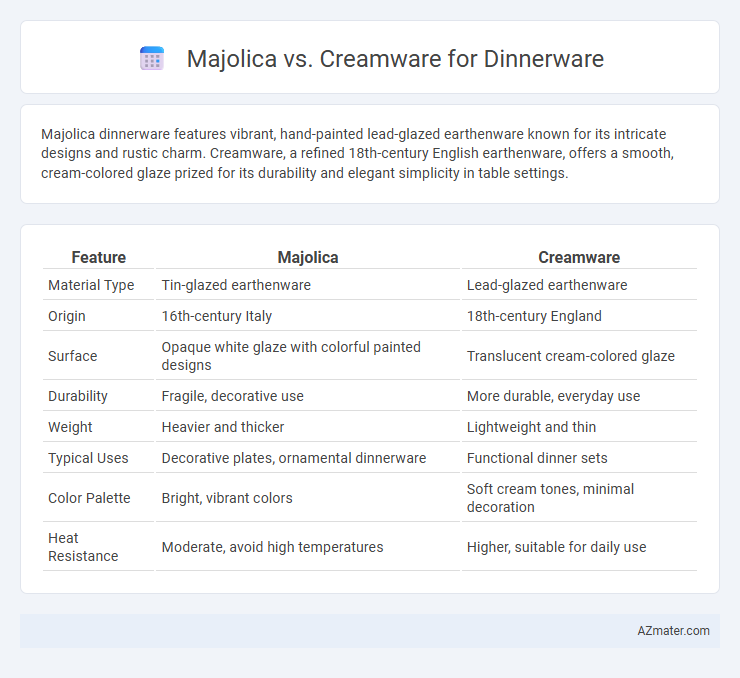Majolica dinnerware features vibrant, hand-painted lead-glazed earthenware known for its intricate designs and rustic charm. Creamware, a refined 18th-century English earthenware, offers a smooth, cream-colored glaze prized for its durability and elegant simplicity in table settings.
Table of Comparison
| Feature | Majolica | Creamware |
|---|---|---|
| Material Type | Tin-glazed earthenware | Lead-glazed earthenware |
| Origin | 16th-century Italy | 18th-century England |
| Surface | Opaque white glaze with colorful painted designs | Translucent cream-colored glaze |
| Durability | Fragile, decorative use | More durable, everyday use |
| Weight | Heavier and thicker | Lightweight and thin |
| Typical Uses | Decorative plates, ornamental dinnerware | Functional dinner sets |
| Color Palette | Bright, vibrant colors | Soft cream tones, minimal decoration |
| Heat Resistance | Moderate, avoid high temperatures | Higher, suitable for daily use |
Introduction to Majolica and Creamware
Majolica is a type of tin-glazed pottery characterized by vibrant, colorful glazes and intricate raised designs, often featuring floral and natural motifs. Creamware, developed in the 18th century by English potter Josiah Wedgwood, is recognized for its smooth, cream-colored body and refined, utilitarian shapes, prized for both durability and elegance. Both styles represent significant innovations in ceramic artistry, with Majolica emphasizing decorative appeal and Creamware focusing on functional sophistication.
Historical Origins and Development
Majolica dinnerware originated in the Renaissance period, characterized by its vibrant tin-glazed earthenware techniques developed in Italy during the 15th century, favoring intricate hand-painted designs. Creamware emerged in 18th-century England as a refined, cream-colored earthenware developed by potter Josiah Wedgwood, valued for its durable, elegant, and affordable qualities. The evolution of Majolica emphasized vibrant, decorative ceramics, while Creamware focused on practical, mass-produced tableware suited to growing middle-class demands.
Key Characteristics of Majolica
Majolica dinnerware is characterized by its vibrant, colorful glazes and intricate raised relief patterns that create a textured surface, distinguishing it from the smoother, more subdued creamware. This tin-glazed earthenware is typically hand-painted with bright hues, often featuring floral or natural motifs, making each piece uniquely decorative. Its porous body, coated with a lead or tin glaze, provides durability while maintaining a distinctive rustic charm compared to the finer, cream-colored stoneware of creamware dinner sets.
Distinctive Features of Creamware
Creamware dinnerware is characterized by its light cream or ivory color, achieved through a refined earthenware body coated with a clear lead glaze, making it more durable and less porous than earlier pottery types. Its thin, delicate forms with smooth surfaces and subtle glaze variations set it apart from the heavier, more brightly colored Majolica. Originating in the mid-18th century, Creamware became popular for everyday use due to its elegant yet practical design and ability to imitate porcelain at a lower cost.
Comparing Aesthetic Appeal
Majolica dinnerware features vibrant, hand-painted glazes with intricate floral and natural motifs that create a rustic yet richly decorative aesthetic, perfect for adding a splash of color to any table setting. Creamware, developed in the 18th century, offers a smoother, cream-colored surface with a refined, understated elegance, often glazed with a soft ivory tone that complements both casual and formal dining environments. The choice between Majolica and Creamware hinges on the preference for bold, textured artistry versus sleek, minimalist design.
Durability and Practicality for Dining
Majolica dinnerware, known for its vibrant, hand-painted glazing, tends to be less durable due to its porous nature and susceptibility to chipping, making it more suitable for decorative use rather than everyday dining. Creamware, a type of refined earthenware with a durable, lead-free glaze developed in the 18th century, offers enhanced practicality for daily use due to its resistance to chipping and compatibility with modern dishwashers. For durability and practicality in dining, creamware outperforms majolica by combining elegant aesthetics with robust functionality designed for regular meal service.
Popular Uses and Applications
Majolica dinnerware features vibrant, colorful glazes, making it popular for decorative table settings, garden parties, and artisanal dining experiences. Creamware, with its smooth, creamy finish, is favored for everyday use and elegant formal dining due to its durability and timeless appeal. Both types enhance aesthetic value but serve different functions: Majolica excels in ornamental presentation, while Creamware is prized for practical, versatile dinnerware.
Collectability and Market Value
Majolica and Creamware both hold distinct appeal for collectors, though Majolica's vibrant, hand-painted glazes often command higher market value due to their artistic uniqueness and rarity. Creamware, known for its refined, buff-colored earthenware body and subtle decoration by Wedgwood in the 18th century, remains highly collectible for its historical significance and classic aesthetic, typically trading at moderate prices compared to Majolica. Collectors prioritize Majolica for decorative impact and limited production runs, while Creamware attracts those focused on neoclassical design and early industrial ceramics.
Maintenance and Care Differences
Majolica dinnerware requires careful maintenance due to its porous surface and vibrant glaze, making it prone to chipping and staining, thus hand washing with mild detergent is recommended. Creamware, being a tougher and smoother earthenware, offers easier care with higher resistance to scratches and stains, allowing for dishwasher use in many cases. Proper storage and avoiding extreme temperature changes are essential for both to preserve their durability and aesthetic appeal over time.
Choosing the Best Option for Your Table
Majolica dinnerware offers vibrant, hand-painted designs with a glazed earthenware finish, ideal for adding color and texture to your table setting. Creamware provides a more understated, smooth cream-colored porcelain look that suits elegant and classic dining aesthetics. Consider Majolica for artistic, rustic charm and Creamware for timeless sophistication and versatility in your dinnerware collection.

Infographic: Majolica vs Creamware for Dinnerware
 azmater.com
azmater.com